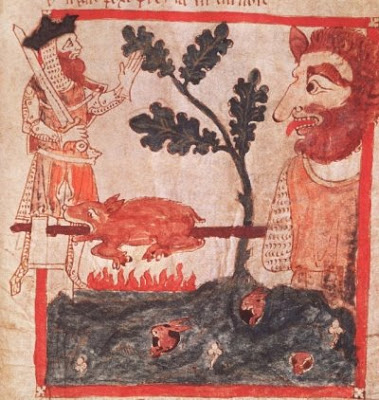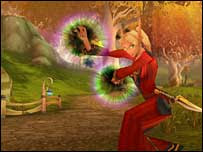This week’s image is from the same Psalter as last week, still available at the still excellent, but still slow, website of the National Library of the Netherlands:

In a departure from the first three installments of marginal images from the Middle Ages brought to you on Monday, this image was, I believe, actually meant to be a joke in its original context.
I’ve mentioned Reynard before at Got Medieval. As you may recall, he is the namesake of the US government’s program for keeping track of terrorists in virtual worlds like World of Warcraft.* Here, we find Reynard depicted on the medieval metaphorical commonplace, the Wheel of Fortune. That’s Lady Fortune in the back.
If you’re unfamiliar with the Wheel of Fortune, you can think of Lady Fortune as half Pat Sajak, half Lady Luck. The turning of her Wheel causes mankind–or in this case, foxkind–to suffer outrageous slings and arrows. The four images represent the four states of man: up top, regno (I reign); on the right, regnavi (I have reigned); on the bottom, sum sine regno (my reign is kaput); and to the left, regnabo (I shall reign).
I’m fairly sure that the image is meant to be Reynard, rather than simply some random dog, fox, wolf, or beaver because the regnabo beast is wearing a monk’s habit. In the stories, eventually Reynard’s friends get fed up with him either eating or f**king all their friends and relatives, so they demand the king do something about him. Reynard pretends to have joined a monastic order and begs their forgiveness. When they back off, he eats them. He’s a clever guy, that Reynard. Another time, he convinces his old buddy Isengrim the wolf to become a monk, because of all the good food they have in monasteries. While Isengrim’s off enduring the monkish equivalent of fraternity hazing, Reynard f***s his wife (again).****
Across the page from the Reynard Wheel, the illuminator depicts a standard Wheel of Fortune, with humans in the proper places:
 Here on the human wheel, note that the reigning king up top is nervously casting his eyes across the page over at the fox-king. He can see that across the page, he’s being mocked by a fox, and it doesn’t make him happy. (Or possibly he knows that Reynard is working for the government.)
Here on the human wheel, note that the reigning king up top is nervously casting his eyes across the page over at the fox-king. He can see that across the page, he’s being mocked by a fox, and it doesn’t make him happy. (Or possibly he knows that Reynard is working for the government.)
This illustrates one of the things that I hope to talk about in future installments of Mmm… Marginalia. Medieval illustrations are often “self aware”: they are drawn as if to indicate that the subjects of the illustrations know 1) that they are pictures and not really the things they depict and 2) that there are other pictures out there doing the same thing. When we see this in modern media, like, say, She-Hulk or Boston Legal, we call it “post-modern,” “post-postmodern,” or “meta-fictional” or some other word that requires a hyphen the first few thousand times its used.***** The medievals were doing it long before Gutenberg invented the hyphen.
—
*If the government were cleverer, it would devote its efforts instead to trying to get as many terrorists playing World of Warcraft as possible, and then just leave them there. It is impossible to blow up a bus full of cherubic American children if you are trying to kit out your pally for raids.
**That wasn’t a footnote, it was an attempt to censor myself and thereby cut down on the number of readers brought here by Google searches for hot Pat Sajak/Reynard the fox slashfic.
***Nope, still not a footnote. Seriously, you need to learn typographical conventions.
****See, this is a proper footnote. It’s here to make the minor, but related point that when the Encyclopedia Brittanic Online mentions this story, it says that Reynard “goes to […Isengrim’s]] house and possesses his wife.” Way to euphemize.
*****See, post-postmodern still needs a hyphen, but postmodern hocked its hyphen for legal fees during the affaire de Sokal.



















Recent Comments